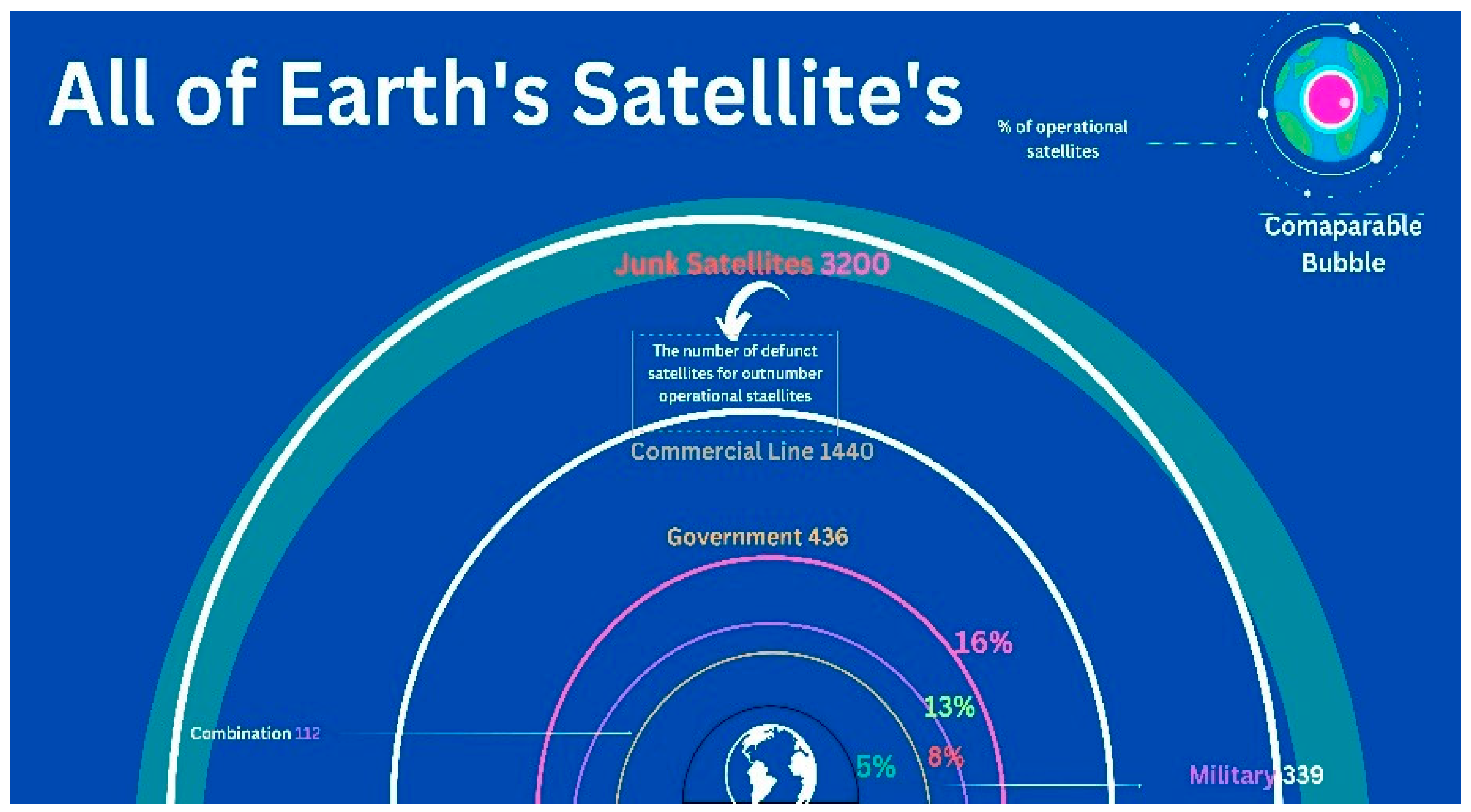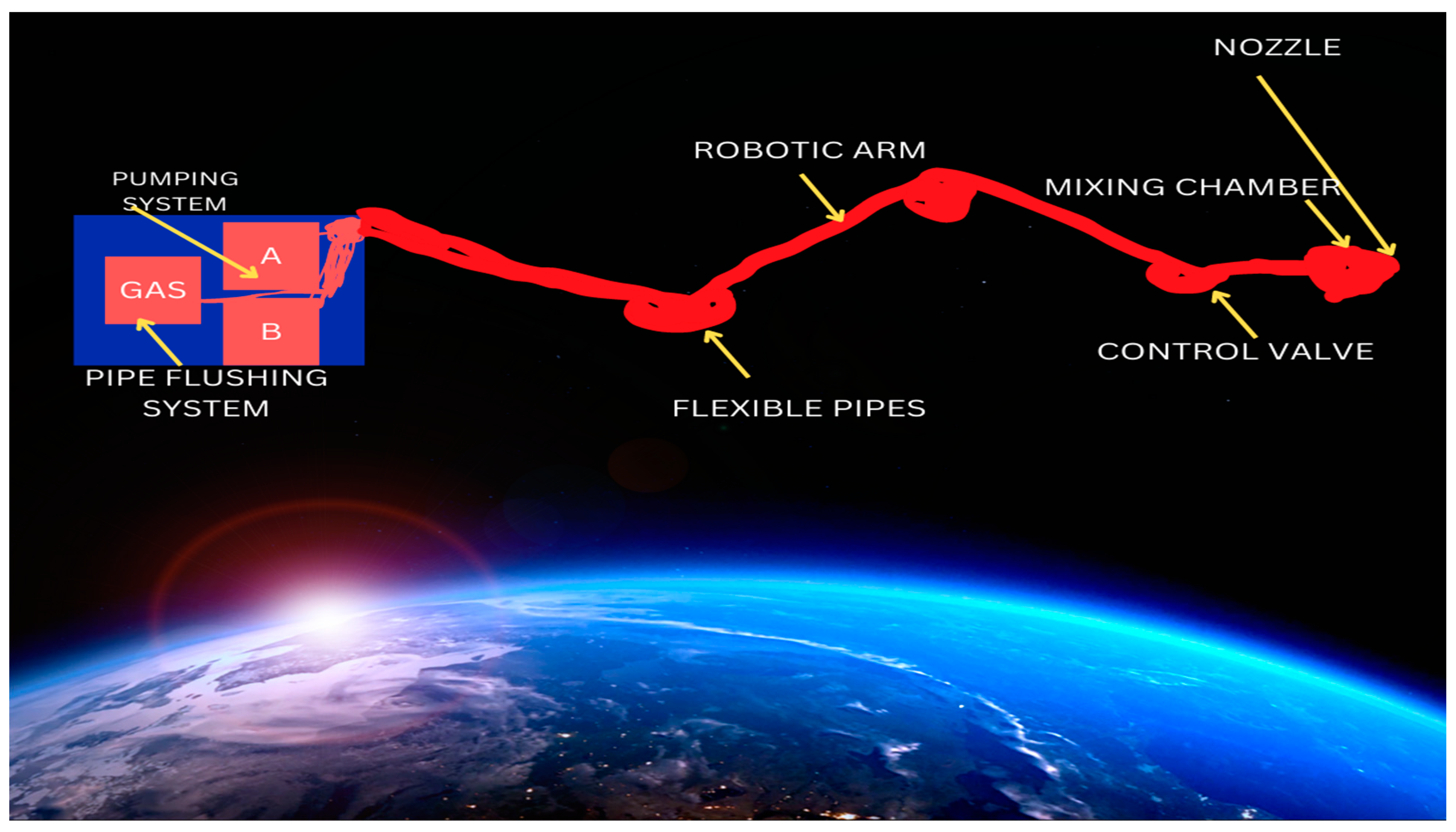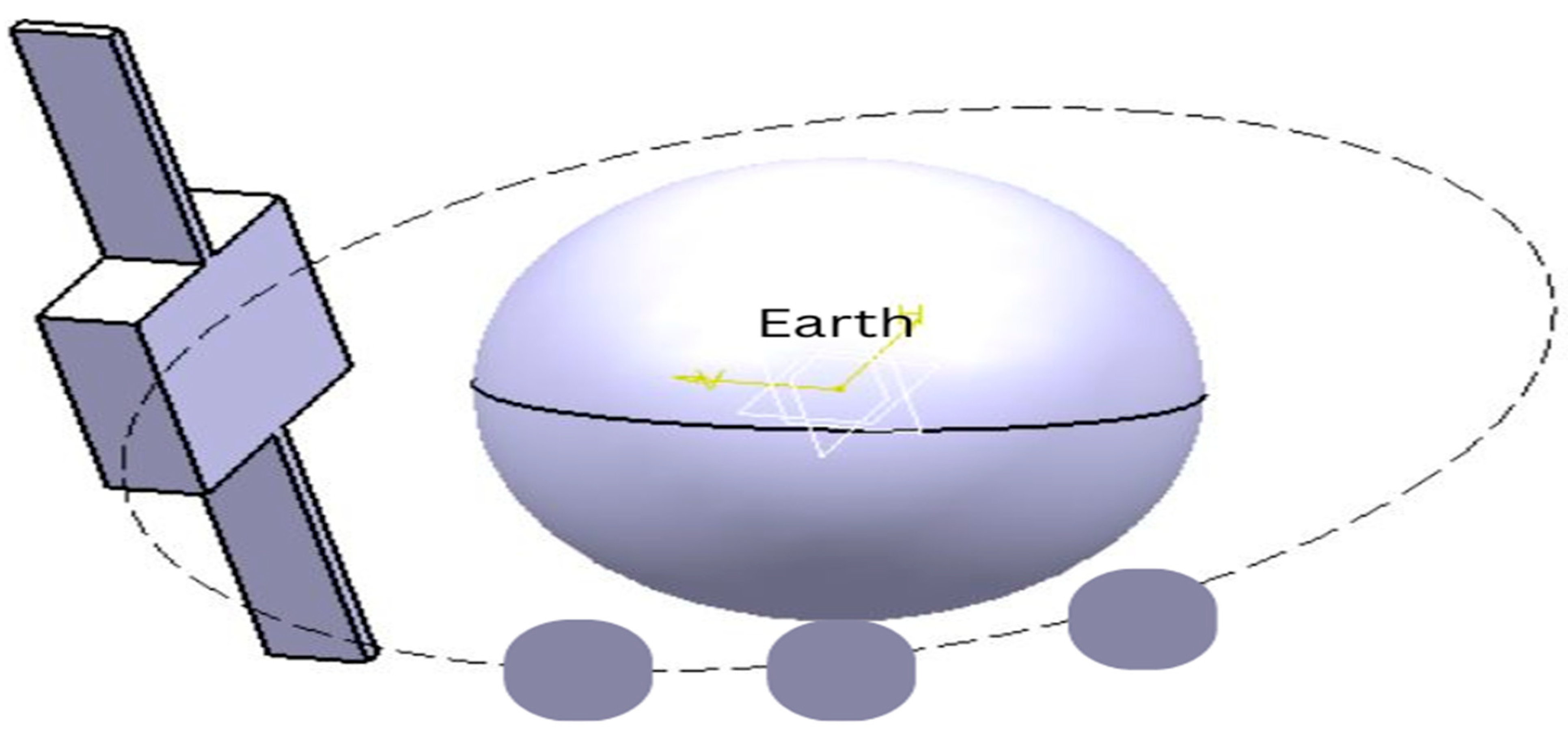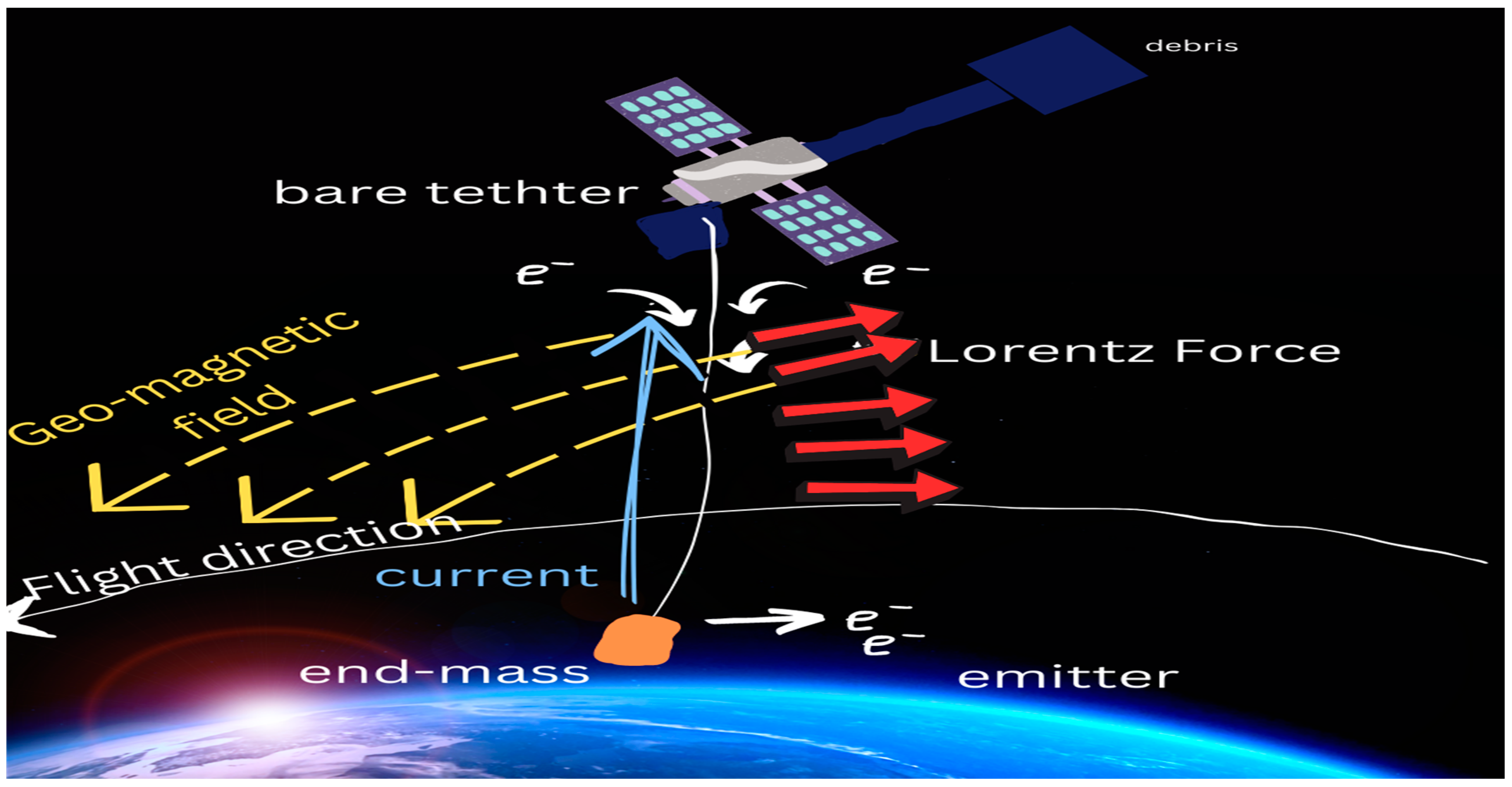Introduction
We humans have been intrigued about Space since earlier time of civilization. As a result of human’s curiosity about Space, it leads to launch of first artificial satellite by the Soviets on October 4, 1957, but it was not the first humanmade space debris because the satellite was launched by using smaller rockets and thus did not move too far from Earth’s surface. Thus after a few months, they eventually returned to Earth’s atmosphere. [
7]
On March 17,1958 the fourth satellite, i.e. American satellite Vanguard 1 was launched, which lead to creation of first humanmade space debris. [
3] Space debris, are the nonfunctional manmade objects orbiting the Earth. There are several reasons for which a device or a part becomes debris. [
7] The first reason is, the satellite without a bult-in mechanisms for returning to the Earth’s atmosphere cannot return after the completion of a mission. Thus, after the completion of mission of a satellite it is defragmented and it becomes a space debris. Second reason is some satellites there is some technical or mechanical complications, after its reach certain height in space and then they either orbit the earth or travel in space. The third is reason due to malfunction in a particular satellite, it gets exploded creating many minutes space debris. Then these minute space debris can also damage other satellites forming new space debris.
While working about space debris removal and solutions, orbit is also needs to be considered as the debris stays in the orbits. [
5] Mainly there are three types of orbits: Low Earth Orbit (LEO), Geostationary Orbit (GEO) and Medium Earth Orbit (MEO). But while discussing about space debris it is important to mention the Graveyard orbit.
LEO (Low Earth Orbit), is usually the most populated orbit located at an altitude less than 1000km. LEO, is also used by International Space station to orbit the Earth at a velocity of 7.8 km/s. [
5]
GEO (Geostationary Orbit), is located at an altitude of 35,786 km above the Earth’s surface. GEO is used by telecommunication and weather monitoring satellites. It takes 23 hours 56 minutes and 4 seconds to complete one circle in GEO. [
5]
EO (Medium Earth Orbit), is usually comprises of both LEO and GEO. One circle using the MEO orbit can take up to 2 to 24 hours. MEO, is generally used for navigation satellites. [
5]
Table I.
A Density of humanmade objects in individual orbits.
Table I.
A Density of humanmade objects in individual orbits.
| Type of orbit |
Payload |
Rocket body |
Space debris |
| LEO |
5596 |
938 |
11023 |
| MEO |
579 |
933 |
2111 |
| GEO |
880 |
115 |
26 |
Figure I. 1.
All active and inactive satellites.
Figure I. 1.
All active and inactive satellites.
Objects between 1 and 10 cm in size are particularly worrisome because they are too small to be tracked accurately but large enough to inflict severe damage. These pieces can be remnants of satellites, rocket stages, or other spaceborne equipment that have fragmented over time. Over the time space debris has been accumulating on the Earth’s orbit at an accelerating rate and now it is a major issue as it poses a major operational threat to functional satellites and spacecraft, as well as future space missions. The major threat that the space debris possess is that it could cause significant damage to the active satellites as well as to future missions. [
12]
Figure I. 2.
All of Earth’s satellite.
Figure I. 2.
All of Earth’s satellite.
Figure I. 3.
Monthly number of registered objects present in Earth’s orbits listed by the US Space Surveillance Network.
Figure I. 3.
Monthly number of registered objects present in Earth’s orbits listed by the US Space Surveillance Network.
Kessler Syndrome, or Kessler effect was a theoretical scenario proposed by NASA scientist Donald J. Kessler in 1978, in an academic paper titled "Collision Frequency of Artificial Satellites: The Creation of a Debris Belt." This phenomenon states that over the time different humanmade objects have accumulated in space and thus it may result in the impossibility of sending new satellites to certain parts of Earth orbit. Kesler Syndrome states that when the number of debris will reach a certain limit, a cascading effect will get triggered, resulting that any collision of debris will trigger in further collisions and it will continue to increase, creating uncountable number of space debris and damaging active satellites and preventing launching of new satellite. [
7]
In the table we have classified the number of objects in space according to their sizes.
Table I.
B Number of objects in space with respect to sizes.
Table I.
B Number of objects in space with respect to sizes.
| SIZE OF OBJECT |
NUMBER OF OBJECTS |
| > 10 CM |
More than 30,000 |
| 1CM - 10CM |
1000000 |
| < 1 CM |
130 million |
Since the first creation of space debris in 1958, presently there are more than 36,000 pieces of space debris objects greater than 10 cm, 1000000 space debris objects from greater than 1 cm to 10 cm, and 130 million space debris objects from greater than 1 mm to 1 cm., and more than 30,000 space debris pieces are tracked by space surveillance networks. Space debris, in the lower earth orbit orbiting the Earth at speeds between 7 to 8 km/s can cause substantial damage upon impact due to the enormous kinetic energy involved. [
7,
12]
II. Space Debris Mitigation Guidelines of the Committee on the Peaceful Uses of Outer Space
The United Nations Committee on the Peaceful Uses of Outer Space has paid particular attention to the issue of preventing and minimizing the creation of space debris. They have also laid down the following guidelines should be considered for the mission planning, design, manufacture and operational (launch, mission and disposal) phases of spacecraft and launch vehicle orbital stages: [
17]
Guideline 1: Limit debris released during normal operations.
Guideline 2: Minimize the potential for break-ups during operational phases.
Guideline 3: Limit the probability of accidental collision in orbit.
Guideline 4: Avoid intentional destruction and other harmful activities.
Guideline 5: Minimize potential for post-mission break-ups resulting from stored energy.
Guideline 6: Limit the long-term presence of spacecraft and launch vehicle orbital stages in the low-Earth orbit (LEO) region after the end of their mission.
Guideline 7: Limit the long-term interference of spacecraft and launch vehicle orbital stages with the geosynchronous Earth orbit (GEO) region after the end of their mission.
III. Removal Methods and Solutions
Figure III. 1.
Various space debris removal methods and solutions.
Figure III. 1.
Various space debris removal methods and solutions.
A. Space Environment based Methods
1. DRAG AUGMENTATION METHOD
The main principle of Drag Augmentation Method is to increase the area to mass ratio of the space debris. As a result of it atmospheric drag will increase and the debris object will re-enter the Earth’s atmosphere where it will ultimately burn. This drags enhancement technique enables uncontrolled re-entry in the absence of a docking system. [
7,
21]
This drag augmentation method is classified into three main methods foam based methods, inflated methods, and fiber-based methods of space debris removal.
1. a. Foam based method
The concept behind foam-based debris removal is to deploy foam projectiles or nets that can entangle and safely capture debris objects. The foam-based removal of space debris includes foam projectiles which can entangle and are more helpful in capturing the space debris. They are a lightweight material that can also be modify themselves into different sizes according to the size of the debris particle and this adaptability allows for the capture of various types of debris, including non-cooperative objects that may lack traditional docking mechanisms or handles for capture. Once the foam is made in contact with the debris, the foam expands and engulfs the object, which reduces the orbital velocity of the debris object and the captured debris will gradually decelerate with the foam-based capture devices due to atmospheric drag. The captured debris can be deorbited to an atmospheric layer, where it will naturally re-enter and burn up during atmospheric reentry, minimizing the risk of generating additional debris. [
2,
7].
Figure III. A.1.a.
Foam based method.
Figure III. A.1.a.
Foam based method.
The foam-based methods offer a relatively a safer and non-destructive way for removing space debris, however this method is still in experimental stage and there several issues to be checked which includes reliability and durability. Continuous research and development will be crucial in developing foam-based methods as an effective solution for space debris removal. [
16]
1. b. Inflated based method
Inflated based method, is same as foam-based method, but here instead of foam, inflated balloon or inflated drag sails are used. These balloons or drag sails are deployed and inflated near the space debris, to create a larger surface area that interacts with a thin surface area. The increased surface area will interact with the Earth’s atmosphere resulting in to increase atmospheric drag, leading to re-entry into Earth’s atmosphere. These inflated techniques do not have any scientific evidence but a practical and comprehensive understanding of the complexities involved in removing space debris. [
2,
7].
Figure III. A.1.b.
Inflated method.
Figure III. A.1.b.
Inflated method.
1. c. Fiber based method
The working of fiber-based method is related to the foam-based method, but here instead of foam, a lightweight, strong thread like structure, i.e., fiber is used.
The fiber will be extruded from the system to the debris objects, to capture all the debris objects from the atmosphere by wrapping the fiber around it and forming a strong connection. The debris connections are controlled thus the movement. Two parts of the fiber-based techniques are introduced deorbiting or bringing back to the earth’s surface The deorbiting includes the collection of space debris and making them deorbit and leaving it the outer space itself, the second one is collecting the debris from outer space and taking it back to the earth’s surface. [
2,
7].
Fiber-based debris removal offers several advantages. Fiber based debris removal methods helps to capture numerous numbers of debris objects at the same time. It also allows us to bring the debris object to Earth surface giving a scope to re-use the objects in future space missions.
Figure III. A.1.c.
Fiber based method.
Figure III. A.1.c.
Fiber based method.
2. ELECTRODYNAMIC TETHER
Electrodynamic Tether, is one of the most promising technology for space debris removal. The principle of EDT is as follows (
Fig.III. A.2.a).
While space system moves through the Geo-magnetic field in its orbit around the Earth, the tether deployed will be deployed from the system and an electromotive force is generated. EDT system consist of plasma contractors at either end of the tether, which allows the flow of current in both the direction. The plasma contractors, at either end radiate electrons and collect electrons. Then, an electric current flow through the tether by closing the circuit via ambient plasma. Due to the interaction between Earth’s Geo-magnetic field and electric current generated through tether, a Lorentz Force is generated, which acts opposite to the direction of flight. Thus, EDT, is a high-efficiency system for space debris-deorbit. The thrust generated by the EDT is also without any propellant, and thus it’s a very promising non-chemical thruster of the new space age and a promising technology for space debris mitigation.[
9,
10,27].
Figure III. A.2.a.
Principle of EDT.
Figure III. A.2.a.
Principle of EDT.
EDT’s debris removal system is studied in JAXA. In this method, small EDT system (Figure 4), consist of bare tether, reel mechanism, collector and emitter are sent into space and each EDT system are to be attached to each debris to dispose it. The EDT system attached with space debris will descend till they reach the first layer of Earth’s atmosphere. Moreover, this EDT system can also be attached with satellites for post mission disposal.
Figure III. A.2.b.
EDT system for space debris removal.
Figure III. A.2.b.
EDT system for space debris removal.
3. SOLAR RADIATION
Solar radiation, or the electromagnetic radiation emitted by the Sun specifically the pressure of sunlight, can be harnessed to remove space debris using a solar sail to influence the orbit and altitude of space debris. A solar sail
(Fig.III. A.3.a) is a large reflective sail that captures and utilizes the momentum carried by photons in Sunlight to propel an object in space. When this technique applied to space debris removal, then a solar sail can be attached to a debris object, which will alter its orbit and trajectory by utilizing the solar radiation pressure, ultimately leading to safe removal of space debris.[
2,
15,
19].
Figure III. A.3.a.
A solar-soil in Earth’s orbit to catch the space debris.
Figure III. A.3.a.
A solar-soil in Earth’s orbit to catch the space debris.
The concept of using solar sail to remove space debris is based on the principle of momentum transfer. Photons, the particles of light possess momentum, and when they interact with the reflective surface or the solar sail of the debris removal system, they transfer the momentum to the reflective surface. The individual force exerted by a single photon atom is small, but the cumulative effect of countless photon will produce a significant amount of thrust.
By attaching a solar sail to a debris object, the sail captures the momentum from the photon the particles, and generate a continuous force that acts as a propellant. This force opposes the objects’ orbital motion and gradually alter its trajectory. The pressure generated through solar radiation pushes against the debris object, effectively changing its orbit and causing it to move towards a trajectory that intersects the Earth’s atmosphere. As the debris orbit is modified and it eventually enters an orbit with lower altitude, which exposes the object to increased atmospheric drag, which decreases the debris orbital velocity, eventually leading to reentry into Earth’s atmosphere. Upon reentry, the high temperatures generated by atmospheric friction cause the debris object to burn up, ensuring its complete destruction. There will be small thrusters attached to the solar sail which will ensure the change of direction of entry of the debris object in the earth’s atmosphere as after burning it should be disposed off in a vacant place.
Solar radiation-based methods have been proposed for space debris removal as they offer several advantages. Firstly, they rely solely on the energy provided by sunlight, eliminating the need for onboard propellants or additional power systems. This makes them a sustainable and efficient solution for long-duration missions. Additionally, solar sails can be deployed over extended periods, enabling continuous and gradual orbit adjustments. This flexibility allows for precise control of the debris object's trajectory, minimizing the risk of collision with operational satellites or other space debris. Furthermore, solar sails offer a non-intrusive approach to space debris removal. By attaching a sail to the debris object, it can be influenced without the need for physical contact or propulsion systems that may further contribute to debris generation. And most importantly, solar radiation methods have low launch costs.
However, it is important to note that solar radiation-based methods, including solar sails, have certain limitations. The effectiveness of a solar sail depends on factors such as the size and shape of the sail, the distance from the Sun, and the orientation concerning the sunlight. These factors can influence the magnitude of the radiation pressure and the resulting force exerted on the debris object. In conclusion, solar radiation, specifically through the utilization of a solar sail, presents a viable method for space debris removal. By capturing and utilizing the momentum carried by sunlight, a solar sail can influence the orbit and altitude of debris objects, ultimately leading to their safe disposal through atmospheric reentry. Solar sails offer a sustainable, non-intrusive, and continuous approach to mitigating the risks associated with space debris, contributing to the long-term sustainability of space exploration and satellite operations.
Figure III. A.3.b.
A solar sail attached to a space debris.
Figure III. A.3.b.
A solar sail attached to a space debris.
B. Non-space Environment based methods
1) CONTACT REMOVAL
Contact removal methods are crucial for addressing the growing problem of space debris. Two prominent techniques proposed for contact-based removal are the slingshot method and adhesive methods. These methods offer potential solutions to effectively remove debris from orbit and mitigate the hazards it poses to active satellites and future space missions.
a) Slingshot method
The slingshot method involves utilizing a spacecraft to approach the space debris, establish a connection with it, and then utilize the debris’ own momentum to propel it out of orbit. The University of Texas developed the satellite called Sling-Sat Space Sweeper.
In this method, the spacecraft would be equipped with a robotic arm, which would be used to establish a contact with the debris object. After the contact is established, the spacecraft would use its thrusters to increase the debris object velocity and projecting the debris object to a trajectory which leads to reentry of the debris object in Earth’s atmosphere. But, this method requires precise maneuvers and accurate calculations to ensure successful trajectories and avoid potential collisions with other objects in orbit. [
7,
8].
Figure III. B.1. a.
Slingshot Method.
Figure III. B.1. a.
Slingshot Method.
b) Adhesive Method
Adhesive contact-based removal introduces the concept of using sticky substances to capture and eliminate debris from orbit. The fundamental idea behind this approach is to develop an adhesive material that can be deployed in space to capture and bind the debris. Once the debris adheres to the sticky material, it can be subsequently retrieved and pulled back towards Earth. During reentry, the captured debris will experience the intense heat generated by atmospheric friction, causing it to burn up and disintegrate harmlessly.
Figure III. B.1. n.
Adhesive Methods.
Figure III. B.1. n.
Adhesive Methods.
Adhesive contact-based removal, offers the potential for capturing smaller and more diverse debris, which may be challenging to address through other means. The development of advanced adhesive materials that exhibit appropriate adhesive properties in the harsh space environment is a key aspect of this approach. Additionally, retrieval and disposal of the adhesive-bound debris must be carefully planned to prevent any unintentional release during the return process [
7,
8].
2) Contactless removal
Contactless removal methods offer alternative approaches to address space debris without the need for physical contact between the removal system and the debris itself. Among these methods, lasers and ion-based technologies show promise for effectively mitigating the space junk problem.
a) Laser based Method
Laser-based contactless removal involves the use of high-powered lasers to vaporize space debris. When a laser beam is directed at the debris, the intense energy causes the debris to heat up and vaporize. As a result, the debris slows down and experiences increased air drag, causing it to gradually descend and eventually reenter the Earth's atmosphere. [
2]
The laser-based method can be installed in a ground or in a space. This method is particularly effective for smaller-sized debris that may not be suitable for contact-based removal. Precise targeting and tracking systems are required to ensure accurate laser placement and successful removal. Laser-based removal is most effective for smaller debris, while larger objects may require additional measures.
The first laser-based system was called Orion, which can remove space debris with a diameter of about 1 cm in a distance below 500 km range. [
7]
Figure III. B.2. a.
Laser based method.
Figure III. B.2. a.
Laser based method.
b) Ion beam shepherd-based method
Ion-beam contactless removal utilizes a spacecraft equipped with an ion thruster. Ion thrusters generate a stream of charged particles that can interact with space debris. By manipulating the electric field generated by the ion thruster, the spacecraft can attract or repel the debris, depending on the polarity of the field. This technology enables the spacecraft to influence the trajectory and orbital parameters of the debris, gradually altering its orbit and causing it to decay over time. [
2,
20].
In the Ion beam shepherd method, there will be two propulsion system in the satellite. One propulsion system ejects a high velocity and releases highly neutralized ion beam into the space debris. And the other propulsion system which is installed in the opposite side of the satellite body, eject the ion beam in the opposite direction to the ejected beam by the first propulsion system, which leads to better stabilization of the satellite in space. [
7]
The advantage of ion-based contactless removal is that it can be performed from a safe distance, reducing the risk of damage to both the spacecraft and the debris. But the ion reflected from the debris object can contaminate some parts of the satellite. This method is versatile and applicable to a wide range of debris sizes and shapes. However, it is important to note that these methods have their limitations. Ion-based removal requires careful planning and control to achieve the desired orbital changes. [
7]
Figure III. B.2. b.
Ion beam shepherd.
Figure III. B.2. b.
Ion beam shepherd.




















